Motorola Droid Maxx 2's Identical Twin, The Moto X Play: Hands On

Back in the dog days of summer, Motorola announced a handful of new smartphones. Those phones were the Moto X Style/Pure, Moto G (2015) and Moto X Play. Although we've taken a closer look at the first two devices (our Moto G hands-on and Moto X Style hands on), we haven't talked much about the Moto X Play, other than doing a comparison of it with its bigger brother.
That's because until now, this phone wasn't available in the U.S.; it was only being sold internationally (including Canada). Well, that changed on Tuesday with Verizon's announcement of the Droid Maxx 2, the Moto X Play's rebranded twin.
Although we haven't had a chance to check out the new Droid in person yet, we have been able to play with the Play extensively. Because they are basically the same phone, other than the color options and software load, having a closer look at the Play will give you a pretty good idea what to expect from this new Droid.
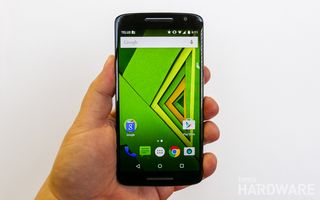
It's important to remember going into this that the Moto X Play and Droid Maxx 2 are mid-range devices, so adjust your expectations accordingly. Even so, with the mid-range becoming almost more important a market segment than the high-end, we do still expect OEMs to produce a phone as well-made as its price-point allows.
Note that while we will mostly be talking about the Play, everything applies to the Maxx 2 unless specifically noted.
Specifications
| SoC | Qualcomm Snapdragon 615 1.7 GHz 64-bit Octa-core processor(4 x Cortex-A53 @ 1.7 GHz and 4 x Cortex-A53 @ 1.0 GHz),Adreno 405 GPU |
|---|---|
| Display | 5.5-inch Full HD TFT LCD (1920 x 1080, 403 ppi) with Gorilla Glass 3 |
| Memory | 16/32 GB eMMC ROM, 2 GB LPDDR3 RAM / microSD slot (up to 128 GB) |
| Camera | Rear: 21MP with f/2.0 aperture & 1/2.4" Sony Exmor RS IMX230 sensor / Dual LED CCT flash, Phase Detect Auto-Focus (PDAF), 1080p HD video (30fps)Front: 5MP |
| Battery | 3,630 mAh (non-removable), TurboPower Charging (15W charger)No wireless charging |
| Operating System | Moto X Play: Pure Android 5.1.1 Lollipop with Moto appsDroid Maxx 2: Pure Android 5.1.1 Lollipop with Moto apps |
| Size & Weight | 148 x 75 x 8.9 to 10.9 mm, 169g (5.8 x 2.9 x 0.35 – 0.43 inches, 5.96 oz) |
| Network | Moto X Play: 4G LTE cat. 6 / HSPA+, Nano-SIMCanadian XT1563 LTE Bands: 1, 2, 3, 4, 5, 7, 8, 12, 17, 28Rest of World XT1562 LTE Bands: 1, 3, 5, 7, 8, 19, 20, 28, 38, 41Droid Maxx 2: CDMA / 4G LTE cat. 6 / HSPA+, Nano-SIMVerizon XT1565 LTE Bands: 2, 3, 4, 5, 7, 13, 20 |
| Connectivity | Wi-Fi 802.11 a, b, g, n / Bluetooth 4.0LE / NFC / USB 2.0 |
| Biometrics | No |
| Audio | Front-ported mono |
| Materials | Plastic, Gorilla Glass 3 |
| Colors | Moto X Play: Black and White, customizable on Moto Maker with 14 different CSR back colors and seven different metal accent colorsDroid Maxx 2: Black with Deep Sea Blue back, White |
| Carriers | Moto X Play in Canada: Bell Mobility, Koodo, TELUS, Videotron andWind MobileDroid Maxx 2: Verizon |
| Pricing | Moto X Play: Starting at $0 CDN on a 2-year term, $400 - $450 CDNoutright (approx. $300 - $340 USD)Droid Maxx 2: $16 per month for 24 months, $384 USD outright |
Hands-On Video
Not Enough Graphical Horsepower
The Moto X Play is powered by Qualcomm's Snapdragon 615 SoC. This mid-range octo-core chip provides adequate horsepower to make the overall experience of using the Play smooth and pleasant (which is also helped by its almost-stock Android software). However, the 615's GPU is seriously underpowered when compared to its competition.
Although you shouldn't expect the same level of performance from a mid-range phone as from a high-end device that costs considerably more, the Adreno 405 is slower that the Adreno 330 GPU of last year's Snapdragon 800/801 SoC. The Play's scores landed around 8,016 in 3D Mark when we tested it; by comparison, the 801-powered OnePlus One scored 19,691, which is more than double. Although this deficiency doesn't impact the performance of general application usage, it does mean that graphically demanding games are going to chug on the Play – which is ironic, given the device's name.
Stay On the Cutting Edge: Get the Tom's Hardware Newsletter
Join the experts who read Tom's Hardware for the inside track on enthusiast PC tech news — and have for over 25 years. We'll send breaking news and in-depth reviews of CPUs, GPUs, AI, maker hardware and more straight to your inbox.
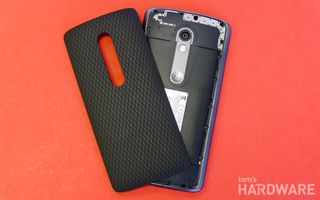
The problem with using the 615 is that it doesn't seem to be matched properly to the rest of the phone's specifications. When we tried the new Moto G, which uses a slower Snapdragon 410 SoC, its GPU is better matched to its 720p display, and Android runs buttery smooth on it. Still, this isn't necessarily Motorola's fault, and the blame lands more on Qualcomm, whose mid-range SoC offerings this year have been lackluster. To hit the price point it wanted, Motorola didn't have any other choice than to use the 615 in the Moto X Play and Droid Maxx 2.
The balance of the Play's specs are as expected for a 2015 mid-range device, and it's good to see that Motorola is still a believer in expandable, removable storage.
Display And Screen-To-Body Ratio Leadership

Although we weren't too impressed with the Play's chipset, its 1080p, 403ppi IPS screen is another story. No, it's not a high-end Quad HD screen, but it is crisp enough and very bright. Further, its color accuracy, at least from our eyeball test, looks to be excellent. At 5.5 inches, it hits the size sweet spot for a 2015 phone, and it is also important to note that the screen-to-body ratio of the Moto X Play is class-leading, at 76 percent. This makes it compact for a big screen device.
Super-Sized Battery Means Super-Long Battery Life
Of course, the leading feature of the Moto X Play and Droid Maxx 2 is the huge (non-removable) 3,630 mAh battery -- hence the "Maxx" moniker. We haven't been able to properly test its battery life, but the Futuremark PCMark benchmark does report the average battery life shown below for the Play, and we expect the Maxx to perform similarly. The other results are from devices we have tested ourselves with PCMark, not averages from Futuremark's database.
| PCMark | Moto X Play | Moto X Style | Moto G 2015 | Galaxy S6 | Galaxy Note5 | OnePlus 2 |
|---|---|---|---|---|---|---|
| Work Battery Life | 564 mins* | 359 mins | 507 mins | 366 mins | 490 mins | 450 mins |
(*Average battery life of Moto X Play as reported by Futuremark)
As you can see, the Play bests the battery life of all the 2015 phones we have tested, and clearly this is its most impressive feature. Keep in mind, though, that the PC Mark battery test continuously runs a series of tests that simulates normal device use but doesn't take into account periods of inactivity. Motorola claimed up to 48 hours of use, which is likely an exaggeration, but it's still an indication that you'll easily be able to get over a day and a half of use from a single charge, which is impressive.
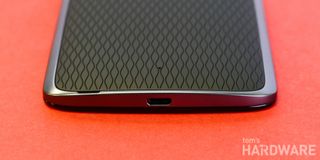
The Play and Maxx 2 also support Qualcomm's Quick Charge 2.0 tech (Motorola calls it "TurboPower") but do not have wireless charging capability. It's also disappointing that the battery is non-removable – the Play isn't that slim, so you'd think that a replaceable battery wouldn't be too much of an engineering challenge.
Attractive, Highly Customizable Design
The Moto X Play continues to use the Motorola design DNA set in 2013 with the first Moto X. For 2015, there is a new metal bar that runs down the spine of the phone from the camera to the Motorola logo. The overall construction of the Play and Maxx 2 is plastic, though the aforementioned bar does have a metal applique.

Although it is an all-plastic device, the quality of the materials used is excellent, and the faux-metal finish of its sides fooled us initially into thinking they were metal. The Play feels like more of a premium device when compared with many other mid-range phones that we've tested.
The back of the phone, which has a nice soft-touch finish, is removable, so you can replace it with your choice of color. In markets where Motorola's Moto Maker service is available, the Moto X Play can be customized with a choice of 14 different back colors. The color of the metal bar can also be customized. In markets without Moto Maker, or if you buy the Play from a retailer or carrier, it is available in black or white.

Here lies one of the main differences between the Play and the Droid Maxx 2: Although the Moto Maker is available in the U.S., the Maxx 2 cannot be customized on it. It comes in either white or black with a Deep Sea Blue back from Verizon. You can still customize the Maxx 2 after purchase by choosing from seven different colored optional backs, though.
Class-Leading Camera
One of the weaknesses of previous Motorola phones has been their cameras, and on its 2015 devices, Motorola has sought to address this by equipping them with class-leading hardware. The Moto X Play has a 21MP camera that uses the new Exmor RS IMX230 sensor, which by all accounts is one of the best currently available. It supports Phase Detect Auto-Focus (PDAF) for fast focusing, and Motorola has combined it with an f/2.0 lens. This means that its low-light performance should be substantially better than its predecessors'.
Our experience with the Play's camera bears this out. For a mid-range device, the camera is excellent, producing detailed daylight shots with pleasing dynamic range, and better low-light photos than its competition. However, it still can't compare to the photographic performance of flagship devices like the LG G4 or Samsung Galaxy S6, due to some issues.
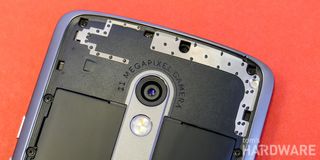
First, camera hardware is only half the story on a smartphone. The image processing done by the SoC's ISP (image signal processor) also plays an important role in how well a picture turns out. Unfortunately, the Snapdragon 615's ISP isn't as powerful as the ISPs found in higher-end phones (which is also the reason the Play can't record 4K video), and this does impact overall image quality.
Second, the Moto X Play's camera software is subpar. We found its UI a little confusing, and it offers only very limited control over the shooting process. More egregiously, Motorola has not supported Google's Camera2 API in the Play's software build, even though it's a feature of Lollipop. This means there are no manual camera controls, and even if you download a third-party camera app that includes them, they won't work on the Play.
Although we haven't been able to test the Maxx 2 to see if the same limitations apply, we don't expect it to be any different.
Stock Android, Almost
In another life, Motorola was owned by Google (Lenovo is now its parent company), so its devices for the past few years have come with a version of Android that is close to stock without being a Nexus device. When the Play was announced in the summer, Android M had not been released, so it was running the latest version of Android at the time. Unfortunately, now that Google's latest OS is available, the disadvantages of running only close-to-stock Android means that the Moto X Play is now an OS step behind.
Another issue is that Motorola was previously one of the best OEMs when it came to delivering speedy updates, but it seems that this commitment has changed under the new ownership. Looking at its upgrade page, at the moment it has committed to updating only six phones in the U.S. to Marshmallow, and left off the list are most of the carrier versions of phones from 2014, apart from the Droid Turbo.

So, while the time difference between the release of the Moto X Play and the launch of Android M means that it is highly unlikely that the Play won't be updated to Marshmallow particularly soon, it's hard to say what the update situation will be for it later in 2016. As for the Droid Maxx 2, it's in the same boat as the Play – we expect to see it updated to Android 6.0, but whether it gets any further updates beyond that is questionable.
Irrespective of the OS update situation, the version of Android on the Play is superior than that found on most other mid-range phones. The Motorola additions to the OS are minimal and consist only of its useful suite of Moto software enhancements, Moto Assist, Moto Voice, Moto Display and Moto Actions. Again, because we haven't had a chance to use the Droid Maxx 2 yet, we aren't sure if the software on it is the same, but we expect it to be, other than the addition of all that Verizon bloatware.
Great Mid-Range Values, With Reservations
The Moto X Play and Droid Maxx 2 both seem to be impressive values and are certainly two of the better mid-range Android offerings on the market today. They are well-designed phones with great screens, class-leading cameras, and some of the best battery life of any smartphones on the market. That battery life will be one of the prime reasons to consider these phones for many users, as the Achilles heel of many of 2015's Android offerings has been the battery life, with the new generation of SoCs using significantly more power than 2014's devices.
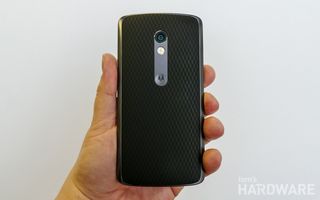
Unfortunately, we do have a few reservations – namely, the Snapdragon 615 SoC, with its too-weak GPU, and the question surrounding OS updates. We appreciate that Motorola is selling phones with an almost-vanilla version of Android, with the only software additions (other than the aforementioned carrier bloat) being a suite of Moto applications that only enhance Android further, but its lack of commitment to keep its phones up-to-date is of concern.
The Moto X Play is available internationally and in Canada from Bell Mobility, Koodo, TELUS, Videotron and Wind Mobile, starting at $0 on a 2-year term contract or $400-450 CDN outright. In the U.S., the Droid Maxx 2 is exclusive to Verizon and is $16 per month for 24 months or $384 outright.
Alex Davies is an Associate Contributing Writer for Tom's Hardware, covering Smartphones, Tablets, and Virtual Reality. You can follow him on Twitter.
Follow us @tomshardware, on Facebook and on Google+.
Most Popular




